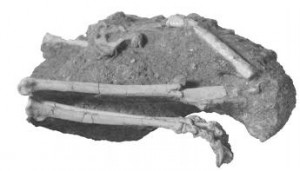Scientists Uncover One of the Smallest Dinosaurs Ever
/https://tf-cmsv2-smithsonianmag-media.s3.amazonaws.com/filer/20110520083305Shuvuuia.jpg)
Another month, another alvarezsaur. In January, paleontologists announced the discovery of a small, one-fingered dinosaur from Inner Mongolia named Linhenykus, and another team of paleontologists has just published the description of a related, slightly older creature in the latest Journal of Vertebrate Paleontology. They named it Albinykus baatar, and it was one of the smallest dinosaurs of all time.
At first glance, the remains of Albinykus do not look like much. Found at the fossil site Khugenetslavkant in the eastern part of the Gobi Desert, this new dinosaur is represented by several bones embedded in a small lump of rock. But once you know what you are looking at, it quickly becomes apparent that this dinosaur died with its legs tucked in under its body. Both legs seem to straddle the sandstone block, with parts of the hip preserved between them. Whatever killed it and preserved this dinosaur kept it in a seated position, just like a bird.
Unfortunately, not much else was left of this dinosaur. Although its legs were preserved in place, geological processes destroyed the rest of its skeleton. Nevertheless, the legs share some peculiar features unique to the alvarezsaurs, a peculiar group of dinosaurs that may be most closely related to the equally strange therizinosaurs. With this discovery, paleontologist Sterling Nesbitt and co-authors state, every "classic" Late Cretaceous locality in the Gobi Desert has yielded at least one of these dinosaurs—the history of alvarezsaurs in prehistoric Asia is very rich.
What makes Albinykus particularly noteworthy, though, is its small size. Nesbitt and colleagues estimate that it weighed only between 1.5 and 2 pounds. Its earlier cousin Patagonykus, on the other hand, is estimated to have been between 77 and 88 pounds, marking a drastic reduction in size over time. As far as is presently known, this degree of size reduction happened only one other time in coelurosaurs (the larger group to which the alvarezsaurs belong), and that was one of the changes involved in the origin of the first birds.
Just how a dinosaur as small as Albinykus made a living, though, remains unknown. Alvarezsaurs had numerous small teeth and very small, stout arms tipped with one large claw (with smaller secondary claws in most known species). This arrangement is broadly similar to the anatomy of mammals such as ant-eaters and pangolins, and so it has been widely hypothesized that the alvarezsaurs were ant-eating dinosaurs. Still, scientists have yet to find an alvarezaur with tell-tale gut contents, a coprolite full of ants, or a preserved termite nest showing signs of damage done by one of these dinosaurs. The ant-eating dinosaur hypothesis is the best one yet proposed, but scientists are still looking for clues as to how alvarezsaurs lived.
References:
Nesbitt, S., Clarke, J., Turner, A., & Norell, M. (2011). A small alvarezsaurid from the eastern Gobi Desert offers insight into evolutionary patterns in the Alvarezsauroidea Journal of Vertebrate Paleontology, 31 (1), 144-153 DOI: 10.1080/02724634.2011.540053
/https://tf-cmsv2-smithsonianmag-media.s3.amazonaws.com/accounts/headshot/RileyBlack.png)

/https://tf-cmsv2-smithsonianmag-media.s3.amazonaws.com/accounts/headshot/RileyBlack.png)